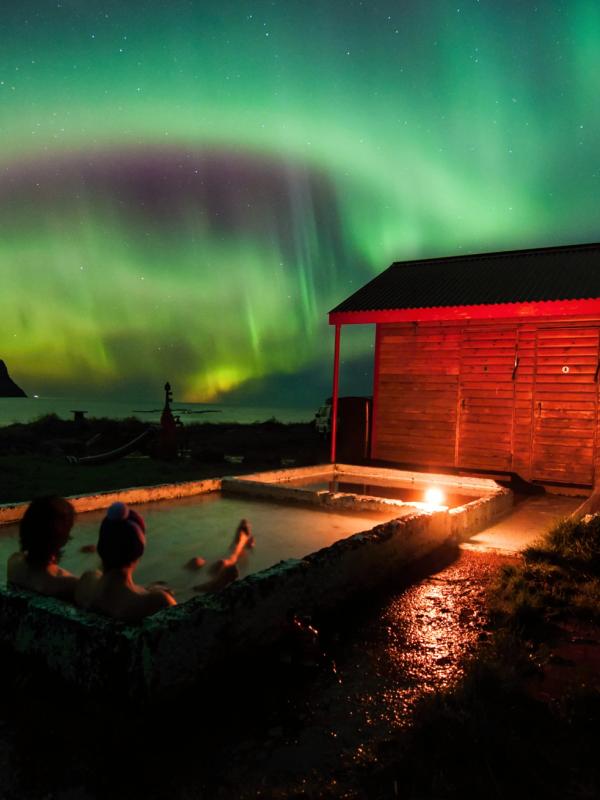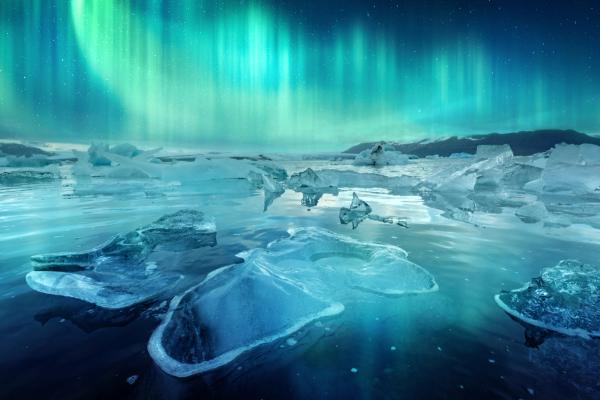
Optimal Season for Viewing Northern Lights in Iceland
Are you looking to witness the breathtaking natural phenomenon of the northern lights in Iceland? Look no further, as we have all the information you need to plan the ultimate aurora borealis experience. From the best time of year to spot the mesmerizing lights to the ideal locations for viewing, we've got you covered. Get ready to be dazzled by the celestial dance of colors in the Icelandic night sky.
How frequently can the northern lights be seen from Iceland?
Experience the breathtaking beauty of the northern lights in Iceland during the prime viewing months of September and March. With increased solar activity around the equinoxes, these are the best times to catch a glimpse of the dancing colors in the sky. Don't miss out on this mesmerizing natural phenomenon - just remember that between late April and early August, Iceland's continuous daylight means you'll have to wait for the darker months to witness the magic.
Iceland's northern lights are a captivating sight throughout the year, with the exception of the summer months, when the sun never truly sets. To make the most of your visit, plan your trip during the optimal viewing periods of September and March. Whether you're a seasoned aurora chaser or a first-time observer, Iceland's unique location makes it a prime destination for experiencing the wonder of the northern lights.
What is the best spot to see the northern lights in Iceland?
If you're looking for the perfect spot to witness the northern lights in Iceland, look no further than the Jokulsarlon Glacier Lagoon. Located by the Vatnajokull glacier, this picturesque setting offers a stunning backdrop for the mesmerizing natural phenomenon. Whether you choose to drive along the Ring Road from Vik or relax on one of the black sand beaches of South Iceland, you're sure to be treated to an unforgettable display of the lights dancing across the night sky.
For a truly unforgettable experience of the northern lights in Iceland, head to the Jokulsarlon Glacier Lagoon. Nestled by the Vatnajokull glacier, this breathtaking location provides the perfect vantage point for witnessing the enchanting display of lights. Whether you opt to take a scenic drive along the Ring Road from Vik or seek out one of the black sand beaches in South Iceland, you're in for a magical night of watching the auroras illuminate the sky.

What is the optimal time to visit Iceland for traveling?
If you're looking for the best month to travel to Iceland for good weather, then July and August are your best bet. With temperatures around 50 to 55 degrees Fahrenheit and long daylight hours, these months are popular for tourists seeking to explore the stunning landscapes and attractions that Iceland has to offer. Additionally, June is also a great time to visit with its 24 hours of daylight, drawing in just as many tourists as the peak of summer. So, if you want to experience Iceland's beauty in optimal weather conditions, plan your trip for the summer months.
Chasing the Aurora: A Guide to Iceland's Best Northern Lights Season
Embark on a mesmerizing journey through Iceland's best Northern Lights season with our comprehensive guide, "Chasing the Aurora." Immerse yourself in the enchanting beauty of the Aurora Borealis as you navigate the prime viewing spots and optimal times to witness this natural phenomenon. From the vibrant hues dancing across the night sky to the awe-inspiring landscapes that serve as the backdrop, Iceland offers a truly magical experience for any avid Aurora chaser. Join us as we unravel the secrets of this celestial spectacle and embark on an unforgettable adventure under the shimmering lights of the Northern Lights.

Iceland's Spectacular Light Show: When to Witness the Northern Lights
Iceland is known for its spectacular natural light show, the Northern Lights. This stunning display of colorful lights dancing across the night sky is a must-see for any nature lover or adventurous traveler. The best time to witness the Northern Lights in Iceland is during the winter months, from September to April, when the nights are long and dark, providing the perfect backdrop for the mesmerizing light show. Visitors can also increase their chances of seeing the Northern Lights by heading to remote locations away from light pollution, such as the countryside or the highlands.
For those seeking an unforgettable experience, witnessing the Northern Lights in Iceland is a once-in-a-lifetime opportunity. The best time to plan a trip to see this natural wonder is during the winter months when the long, dark nights provide the perfect canvas for the dazzling light display. Travelers can enhance their chances of catching a glimpse of the Northern Lights by venturing to remote areas with minimal light pollution, such as the Icelandic countryside or highlands. With a bit of luck and the right timing, visitors to Iceland can witness the breathtaking spectacle of the Northern Lights in all their glory.
Prime Time for Aurora Borealis: Iceland's Ideal Viewing Season
Experience the magic of the Northern Lights during Iceland's prime viewing season. From September to March, the country's dark and clear skies provide the perfect backdrop for witnessing the ethereal dance of the Aurora Borealis. Join countless travelers worldwide as they flock to Iceland to witness this natural phenomenon at its most dazzling.
Iceland's unique geographical location makes it an ideal spot for viewing the Northern Lights. Situated just below the Arctic Circle, the country offers a front-row seat to the stunning light show that occurs when solar particles collide with the Earth's atmosphere. With minimal light pollution and a relatively small population, Iceland provides an unparalleled opportunity to witness the awe-inspiring beauty of the Aurora Borealis in all its glory.
Make the most of your trip to Iceland by planning your visit during the prime viewing season for the Northern Lights. Whether you're a seasoned aurora chaser or a first-time viewer, there's no better time to witness this natural wonder than during the crisp autumn and winter months. Join us in Iceland as we celebrate the prime time for Aurora Borealis viewing and prepare to be mesmerized by the breathtaking display of colors dancing across the night sky.
Unlocking the Magic: The Best Time to See Northern Lights in Iceland
Embark on a once-in-a-lifetime adventure and witness the breathtaking beauty of the Northern Lights in Iceland. Known for its mystical and mesmerizing displays of colorful lights dancing across the sky, Iceland offers a truly magical experience for those lucky enough to witness it. The best time to see the Northern Lights in Iceland is during the winter months, from September to April, when the nights are long and dark, providing the perfect backdrop for this natural phenomenon.
During these months, the skies are clearer, and the chances of seeing the Northern Lights are significantly higher. For the best viewing experience, head to remote locations away from light pollution, such as Thingvellir National Park or the Snaefellsnes Peninsula. Bundle up in warm layers, grab a thermos of hot chocolate, and prepare to be amazed as the Aurora Borealis dances across the Icelandic sky in a dazzling display of colors and shapes. Don't miss your chance to unlock the magic of the Northern Lights in Iceland during the winter months.
Whether you're a seasoned traveler or a first-time visitor, witnessing the Northern Lights in Iceland is an experience that will stay with you forever. So mark your calendars and plan your trip to Iceland during the winter months for the best chance to see this natural wonder in all its glory. Unlock the magic of the Northern Lights and create memories that will last a lifetime in the land of fire and ice.
Conclusion
The best time to visit is during the winter months, particularly from late September to late March, to witness the mesmerizing spectacle of the Northern Lights in Iceland. During this time, the long, dark nights and clear skies provide optimal conditions for viewing this natural phenomenon. Whether you choose to embark on a guided tour or venture out on your own, experiencing the dance of the auroras against the Icelandic landscape is a truly unforgettable experience. Don't miss the chance to witness this breathtaking display of light and color during your visit to Iceland.
